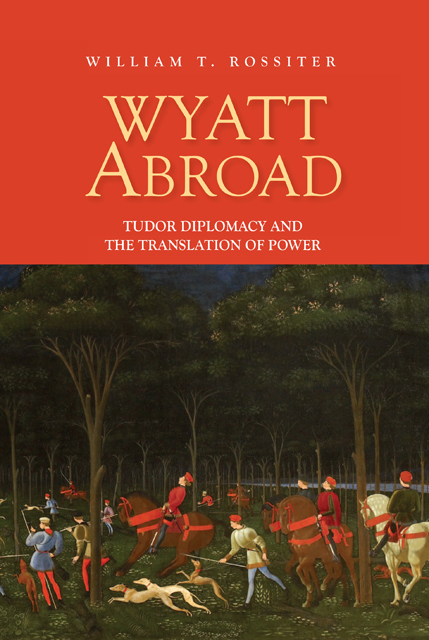Book contents
- Frontmatter
- Contents
- List of Illustrations
- Acknowledgements
- Note on Editions Used
- Abbreviations
- Introduction: The First Reformer?
- Chapter 1 ‘Sovendra du chaseur’: Wyatt in France, French at the English court
- Chapter 2 ‘My galy charged’: Wyatt in Italy
- Chapter 3 ‘So feble is the threde’: Wyatt in Spayne
- Chapter 4 ‘Inward Sion’: Wyatt in Jerusalem – The Penitential Psalms and Soteriological Diplomacy
- Conclusion: ‘In Kent and Christendome’: Wyatt in England
- Glossary of Rhetorical and Literary Terms
- Bibliography
- Index
Chapter 2 - ‘My galy charged’: Wyatt in Italy
Published online by Cambridge University Press: 23 February 2023
- Frontmatter
- Contents
- List of Illustrations
- Acknowledgements
- Note on Editions Used
- Abbreviations
- Introduction: The First Reformer?
- Chapter 1 ‘Sovendra du chaseur’: Wyatt in France, French at the English court
- Chapter 2 ‘My galy charged’: Wyatt in Italy
- Chapter 3 ‘So feble is the threde’: Wyatt in Spayne
- Chapter 4 ‘Inward Sion’: Wyatt in Jerusalem – The Penitential Psalms and Soteriological Diplomacy
- Conclusion: ‘In Kent and Christendome’: Wyatt in England
- Glossary of Rhetorical and Literary Terms
- Bibliography
- Index
Summary
Wyatt And The Italian League
Wyatt’s ambassadorial visit to the Italian peninsula came hot on the heels of his experience at the court of Francis I in 1526. In January 1527 Wyatt accompanied Sir John Russell to the papal court. According to George Wyatt’s now famous anecdote, recorded a century after the event, Wyatt met Russell on the Thames, and asked him, ‘Quo vadis?’ Russell replied:
‘To Italy, sent by the King.’ ‘And I’, said Sir Thomas, ‘will, if you please, ask leave, get money, and go with you.’ ‘No man more welcome,’ the ambassador. So this accordingly done they passed in post together.
As Susan Brigden and Jonathan Woolfson rightly point out, ‘the supposed serendipity of the encounter owes more to a sprezzatura which Thomas Wyatt cultivated (or which his grandson [George] attributed to him) than to the truth.’ In fact, Wyatt would have been more akin to a modern attaché, as Garrett Mattingly notes:
as the importance of resident embassies increased, so did the number of young men of good family who wanted to go abroad with the resident [ambassador]. When such young men were strongly recommended answered by important members of the government, the recommendation was tantamount to appointment … [Political thinkers understood that] the work of the resident embassies required a division of labour and that supplying junior aides for this purpose gave an opportunity for educating future diplomats.
As such, we must be wary of George Wyatt’s attractive anecdote. However, if Wyatt had not cultivated sprezzatura – ‘a certain nonchalance which conceals all artistry and makes whatever one says or does seem uncontrived’ – prior to his Roman embassy, he would certainly have returned with a sprinkling of it, given that Castiglione himself had entered papal service in 1524, and remained papal nuncio until his death in 1529. Indeed, Wyatt’s diplomatic service corresponds with the courtly ideals set out by Castiglione in Il libro del Cortegiano: ‘the courtier should understand about seeking restitution and the conduct of disputes, and he should be skilled in seizing the advantage, and in all this he must show both courage and prudence.’
Wyatt’s Italian embassy, like so much of his diplomacy, was predicated upon ‘conduct of disputes’, and did indeed require both ‘courage and prudence’, not least when he was taken prisoner by Imperial troops after leaving Ferrara in March 1527.
- Type
- Chapter
- Information
- Wyatt AbroadTudor Diplomacy and the Translation of Power, pp. 90 - 122Publisher: Boydell & BrewerPrint publication year: 2014



